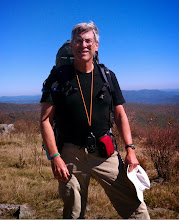Last Saturday was a gorgeous day, and I spent it back in Shenandoah National Park, my first time since the
October Road Scholar week. I picked an area where I'd never hiked, and even been a little intimidated by based on descriptions that is was for experienced hikers only. It's the area in the west of the southern district of the park, in the Big Run, Rockytop, and Brown Mountain wilderness area. I made it into a 10 mile loop over Rocky Mountain and Brown Mountain, returning along the Big Run Portal and Rocky Mountain Run Trail.

On one side was Rocky Top and on the other was Rocky Mount. With all the names including the word "rocky," you might guess that this is a rugged, remote, and rocky area, and you would be correct. The first half of the hike was especially so. Here is the track for the hike, hiking counter-clockwise. Ignore the two straight lines on the west side of the track - I am not sure why the inReach put them in there, but I didn't hike those. The high point of the hike was the start at 2,840 feet, and the low point was at Big Run at about 1,240 feet, with a total of about 2,000 feet of elevation loss and gain. Most of the gain was the 1,600 foot climb out of the Big Run valley.
It was great to explore this area, and get some ideas for future hikes. It's big and remote enough, with so many miles of trail, that I think I need to spend some time backpacking in here. The leaves were starting to change, but there was a lot more green than yellow, orange, red, and brown.
This photo shows an overview of the area that I was going to hike into, mostly downhill, but with one 500 foot climb over Rocky Mountain.
The first really good views were from Rocky Mountain.
After crossing over Brown Mountain - no real view - I crossed through an area that looked like it had once had a forest fire, and not too long ago. It was open and shrubby - not many trees - with views to the Shenandoah Valley.
I didn't see much wildlife on my hike, but in this open area, I did find this really beautiful butterfly - a buckeye:
It was after this point that the trail became even more steep and rocky, descending into heavy forest.
This one looked like a sleepy rock man to me.
After a while, I had good views of the sheer cliffs of Rocky Mount. I remembered
hiking there about seven years ago.
Near the bottom, I looked at the cliffs and talus fields of Rocky Top, across Big Run. I'll save that for another day.
It was nice to reach my lunchtime destination, Big Run. The Big Run watershed is the largest watershed in the park. Another hiker came along there, also for his lunch break, one of the few others I saw on an October Saturday.
After lunch, I started the 5 mile 1,600 foot climb out of the valley. It wasn't as tough as the hike down, actually. Much of it was a steady but gradual climb along a pretty stream through a nice forest. I crossed the stream 4-5 times. In the spring, I could see it being thigh or even hip deep, but I was able to rock-hop with some care, and stayed dry.
I'm not sure why it took me so long to get into this part of the park, but I am glad I did. I had a great time hiking and exploring, and the weather was nearly perfect. I'll be back!















































































